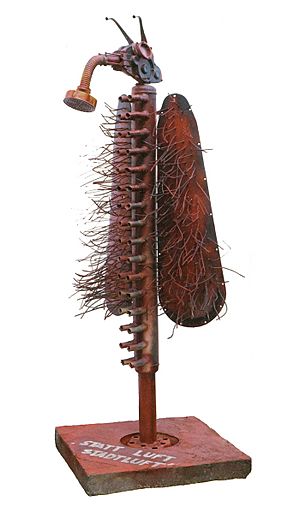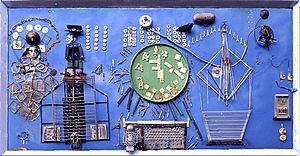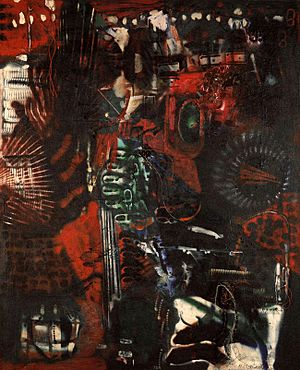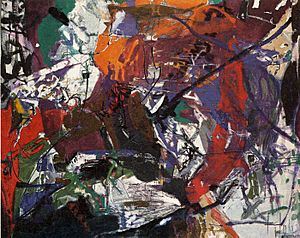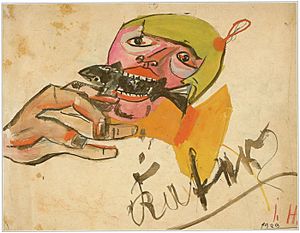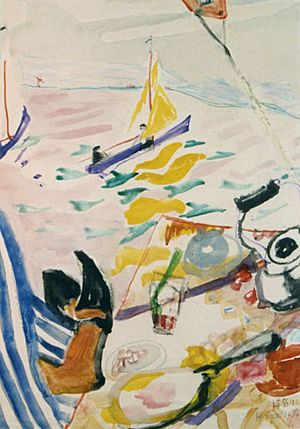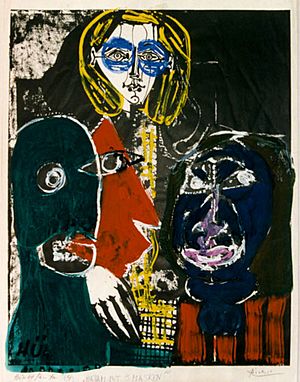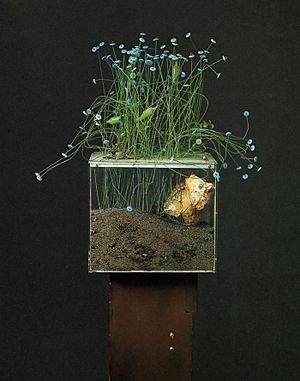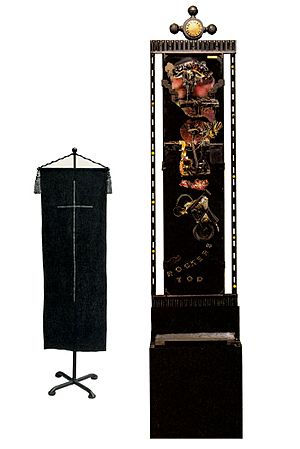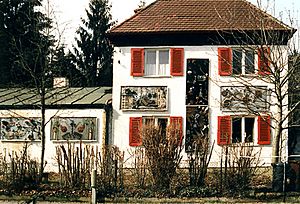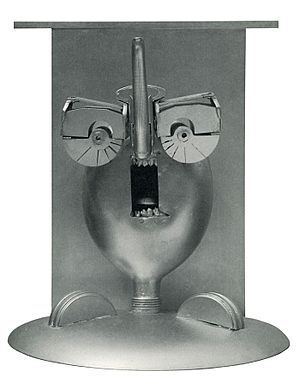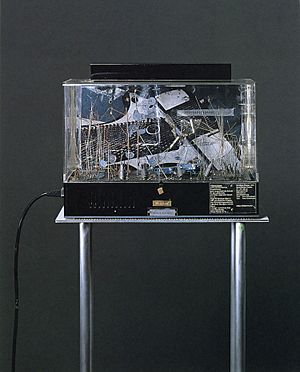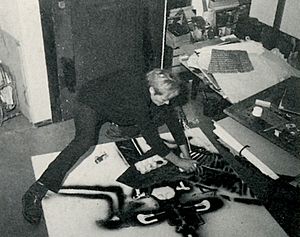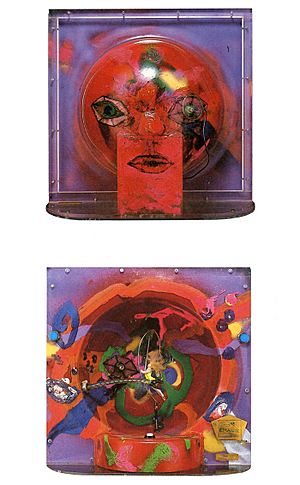Irma Hünerfauth facts for kids
Quick facts for kids
Irma Hünerfauth
|
|
|---|---|
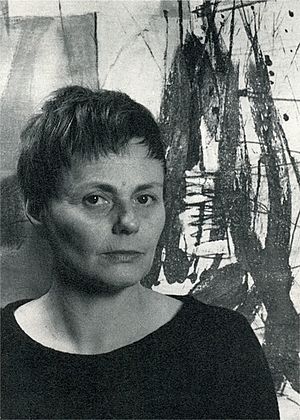
Irma Hünerfauth, 1960
|
|
| Born | 31 December 1907 Donaueschingen, Germany
|
| Died | 11 December 1998 (aged 90) Kreuth, Germany
|
| Nationality | German |
| Education |
|
| Known for | Painting, sculpture and kinetic art |
Irma Hünerfauth, also known as IRMAnipulations, was a German artist (1907–1998). She was a painter, sculptor, and object artist. Irma was famous for turning old junkyard scrap into amazing sculptures and moving art. Her art often made fun of how much stuff people buy and throw away.
She didn't like traditional art rules. Instead, she explored new and exciting art styles after World War II. Her work connects to movements like Abstract expressionism, Fluxus, and Nouveau Réalisme. She was similar to artists like Niki de Saint-Phalle and Jean Tinguely.
Contents
Irma Hünerfauth's Life Story
Irma Hünerfauth was born on December 31, 1907, in Donaueschingen, Germany. Her family moved to Munich in 1914. She started drawing classes for adults when she was just 10 years old.
From 1925 to 1928, she went to the Female Labor School in Munich. Then, from 1929 to 1932, she studied at the Arts School for Design. Later, from 1935 to 1937, she studied painting at the Academy of Fine Arts, Munich.
In 1948, Irma married her third husband, Franz Führer. He was also an artist, known as "Führer-Wolkenstein." He helped her a lot with the technical parts of her art. He even created his own moving art from recycled materials.
In 1954, Irma learned from Conrad Westpfahl, a famous artist. This led her to start abstract painting, which uses shapes and colors instead of real-life images. In 1959, she won an award in Paris for her painting Düsternis (Gloom). Sadly, two artists didn't like it and cut her painting with a knife. Irma had it fixed.
In 1962, she learned how to weld metal. After that, she started making sculptures from scrap metal. In 1965, she started "Gruppe K" (Group K) with other artists in Munich.
Irma stopped painting around 1968. She began creating art that used light, sound, and movement. She made "vibrational objects" and "speaking boxes." These art pieces needed a lot of technical work. Her husband, Franz, was a great help with this.
After Franz died in 1976, Irma made a special monument for him from scrap metal. In the 1980s and 1990s, she started making "Artist's Prayer Books." These were unique small artworks made from tiny electronic scrap.
Irma Hünerfauth received the Schwabinger Kunstpreis in Munich in 1990. She passed away on November 12, 1998, in Kreuth.
Irma Hünerfauth's Art Journey
Irma Hünerfauth started as a painter who drew real-life things. Her early paintings used bold colors and unusual angles. An art critic, Franz Roh, said her paintings mixed calm with movement. She even used a dentist's drill to make some of her prints!
Her teacher, Conrad Westpfahl, helped her move into abstract painting. She began adding different materials to her paintings, like collages. Soon, she started building and constructing art in 3D. These 3D works connected her to the Nouveau Réalisme art group.
Irma always called her artworks "IRMAnipulations." This name was created during an art show in London in 1983. It became her special artistic trademark.
Exploring Her Paintings
Irma's art career began with painting. She learned traditional painting skills at the Academy of Fine Arts in Munich. At first, she painted landscapes and portraits of her family. If she had stuck to that, she would have been a respected painter of that time.
But even her early paintings had a unique style. Sometimes, they showed strong feelings, like the wild shapes in "Pupplinger Au" (1950). This painting reminds some people of Edvard Munch's "The Scream."
From 1954, she started painting in an abstract way. Her painting Winter in Gries (1958) doesn't show any real buildings. It turns them into abstract shapes. She wanted to remove all decorative elements from her art.
Her later paintings were very bold. They tried to balance calm feelings with deep thoughts. Her abstract art often showed strong emotions with lots of colors and rough textures. Some of her works were like Abstract Expressionism and Action painting. These styles were used by artists like Jackson Pollock.
In 1966, she made The red Infamy. In this painting, she attached metal wires to the canvas, like a collage. Her abstract paintings combined strong feelings with clear designs.
In 1969, she painted her "last picture." It had a metal plate with holes on it. It looked like emotions were running wild, powered by electricity. It also had a drain plug and chain, which made fun of the serious art. She was playful and visionary in her art.
But even a large canvas became too small for her ideas. She had already started making sculptures. She decided to focus on 3D art. After this "last picture," she stopped painting. She only left a small number of paintings. Many artists at that time also stopped painting to try new things.
She did return to drawing real things sometimes. For example, she made sketches for her 3D works. She also painted "Mother becomes primordial mother" in 1981.
Her Unique Prints
Irma's printmaking also became very experimental. At first, she made traditional drawings and watercolors. But even her early sketches showed a lot of energy. She used a dentist's drill to make some of her drypoint prints.
She also made linoleum cuts, lithographs, and etchings. She printed most of these in very small numbers. She created "scrap embossing" prints, which were unique. These had pieces of metal or cloth attached to them.
Her "Picasso-variations" were a funny response to a gallery owner. He often said her art was like Picasso's. So, she simply painted over Picasso posters! She also made a series of ten lithographs to remember her friend, Franz Roh.
Irma Hünerfauth's Amazing Artworks
Artist's Diaries and Catalogs
Starting in 1978, Irma began making her own exhibition catalogs. These were like personal art diaries. She glued in pieces from old brochures and news reports. Each catalog had about 50 pages held together with brass screws. These unique diaries are seen as artworks themselves.
Speaking Boxes and Objects
In 1972, Irma created her first "speaking boxes." These were very special and different from other art at the time. The boxes contained various objects, often technical scrap. These objects would move with a motor or make sounds from an audio tape when you pressed a button.
Irma wrote her own instructions for these boxes. She wanted people to touch them, listen, and let their minds wander. She encouraged them to forget everyday life and just be themselves.
Through these objects, Irma showed big ideas about people and society. She explored the sadness of war, the loneliness in big city buildings, and the beauty of nature. She also touched on philosophy and humor.
Moving Vibrational Objects
In the 1970s, she started making "vibrational objects." These were made from wires, buttons, and other found items. When you touched a button, they would make sounds like "music of the spheres."
Irma wanted these moving objects to challenge ideas about what is "fine" or "precious" art. She said, "These vibrational objects are supposed to topple the fine and precious." She wanted viewers to feel a bit uncomfortable as the beautiful objects seemed to "fall apart."
Ferro-montages and Metal Collages
Irma's "ferro-montages" were sculptures made from scrap metal. She used things like car parts, bumpers, and steel pieces. These were shiny, tall figures that she put together or welded with her husband's help. They sometimes looked like religious objects.
One of her most important ferro-montages is called Occam-Mensch (Occam Human). This two-meter-tall sculpture was made in 1971 from machine parts. It has a gas mask and symbolic exhaust pipes. It was shown in Munich and got a lot of attention.
With this sculpture, Irma wanted to highlight climate protection and air pollution in cities. The base of the sculpture had an ironic message: "INSTEAD OF AIR – BIG CITY ATMOSPHERE 'SMOG'." This artwork stayed with her for decades and she updated it several times.
She also made flatter, relief-like artworks called metal collages (assemblage). These were large metal plates decorated with scrap. She even put some of these on the outside of her house. This allowed the weather to naturally change them. She called the materials she used "way too beautiful scrap."
Artist's Prayer Books from Electronic Scrap
After her husband died, Irma focused on smaller artworks. She created "artist's prayer books" from tiny electronic scrap. She used computer parts, wires, and control panels to make small metal collages. Using these materials was very unique.
These small artworks were "silent objects" again. Their small size made people look closely at Irma's designs. She wanted viewers to "step out of themselves" and find new thoughts when looking at her art.
The name "Artist's Prayer Books" was meant to be thought-provoking. It referred to old books for women that were beautifully designed to show religious devotion. Irma's books, made from scrap, asked questions like: Is the computer the new god? Or is it the individual? She added a motto to each book: "Don’t think, wonder yourself!"
Irma Hünerfauth was an important artist from the time after the war. Her artworks are now being rediscovered. Two of her large paintings are displayed at the Städtische Galerie im Lenbachhaus Munich. Her work First Love was also shown in a group exhibition in Berlin in 2019.


